|
Discovering the History of Diamonds
It's Raining, it's Pouring…
For descriptive purposes, I would rather use the words of this children’s song that the famous Czech actor, Kemr uttered in the movie, Na samotì u lesa, which is perhaps fitting but for adults only (In the movie, he said: "It's pissing, it's pissing") A severe rain storm erupted in the evening. The rain stopped after midnight, but when I woke up after 6 a.m., I heard sporadic drops dripping on to the flysheet of my tent. The rain was starting up again, so I moved everything into the camp kitchen. I left the tent standing, so that the damp flysheet could dry out and be less heavy. Immediately after moving, it started to pour, so I had done the right thing at the right time. A neighboring camper – a South African from Pretoria – came to ask me what I was going to do. Whether I would be staying on in the camp for one more day or not. I told him that I was waiting for the hour of decision. This, as my father believed, was at nine in the morning. "The ninth hour will decide", he used to say. I postponed the deadline by one hour and it was just as well that I did. Blue skies appeared at 9.30 a.m. It stopped raining and I could set off by 10 a.m.
Groblershoop was 117 km away. Against a strong wind and endless hills and descents, I was not sure at all if I would get there, so I mentally practiced searching for various possibilities of sleeping beside the road. But that was unnecessary, as various accommodation options eventually appeared, some with campsites, so I believed that I would manage to find something in Groblershoop. At 3 p.m., the wind turned and started to blow favorably from 8 o'clock. I knew that would be a problem because the wind from any direction, other than from the South, brings bad weather to this area. And it sure did. The sky clouded over, lightning flashes began to cut across the darkening sky. However, due to the delay in the sound of the thunder, I knew that the storm was not close.
Groblershoop
I entered the town as the rain started to fall. This was suppressed by a gale with the force of Hurricane Katrina. I inquired about accommodation, the only possibility was one guesthouse, fortunately situated on the Kimberley Road. The windstorm brought billows of swirling dust. The clouds were as black as ink and threatening to release tons of water at any moment. Nevertheless, loyal to my principles, I did not make it easy for my kidneys and cycled to a liquor store, a kilometer away. Outside the store, as usual there were several drunk and stinking hobos. One of them immediately rushed up to my bicycle. I recalled lions who are able to pacify and conquer their surroundings with their body language. So I tried it on him. I gestured with my finger to the man almost a head taller than me to come to me and informed him in a neutral voice that if he only touched the bike, I would break his jaw. His jaw dropped and he began to curse, but he backed away from me as if I was a leper. I calmly bought a beer for the evening and returned to the crossroads to Kimberley. I was informed by the guesthouse that they were full. What now? Fortunately I discovered a road sign advertising the Kheis River Lodge, just 10 kilometers away.
The Right Time and Place
With the wind almost behind me, and the rear flashing light on, I raced among flashes of lightning. I consistently counted the delay between the lightning and thunder, it was one to three kilometers away. In vain I tried to solve a Physics problem: Can a cyclist be struck by lightning if he is insulated by tires? I was glad that I did not have to prove it experimentally because I reached the Kheis River Lodge intact. But the sight of me must have been quite impressive, as one driver even turned back and offered to take me me by car wherever I needed to be. I was a bit wet, but everything was OK. As soon as I closed the front door at Reception, a 10-minute hailstorm erupted, which would have given me a really hard time out on the road.
The owners of the Lodge are those kind of people who do something for pleasure and not for the money. They told me: "We have a covered terrace in the camp, nobody uses it. Switch on the lights there and do anything you like. Don’t worry, nobody will steal anything." So again I had luxurious accommodation for a reasonable 100 Rands. I pitched the tent without a flysheet on a piece of new carpet which was there and was glad that I had not resisted the various offers and had purchased a tent which needs no anchoring.
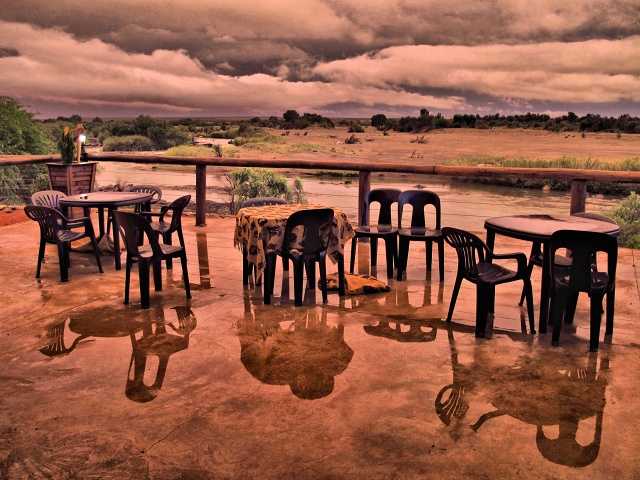
[Kheis River Lodge ] Terrace, where I was staying
Before leaving the camp, I inquired about the conditions ahead. Well, there was nothing favorable. The closest possible accommodation was in Griquatown (Griekwastad in Afrikaans on the road signs), which was 125 km away, after plenty of hills. I had a 5-liter reserve of water so I was not worried. Finally, I made it, although the finish was quite hectic. During the last 15 km, when I already thought I was over the worst, all the steep inclines started, when I had to stomp on the pedals, followed by another descent, and again a steep uphill. I had to make some sweet tea to revive the exhausted body a little. During the last 10 km I certainly searched for places beside the road where I could sleep. I found two spots but neither were really safe.
Griquatown, or Griekwastad
After arriving in the town, I performed the basic lifesaving operation of buying a beer. For those who do not understand it, this deed secures the basic necessities of life. They had my favorite Castle Milk Stout and so I looked forward to pouring it down my throat. I cycled to the local Caravan Park, but oops! It was definitely closed. A man living across the street willingly directed me to the guesthouse two blocks further on. There were even two guesthouses, but both were closed and the only contact was a telephone number on the board. I do not carry a phone, so I copied the numbers and wanted to start searching for a phone booth. Across the street I spotted a young lady. I explained the situation to her and she immediately began to chat on her cellphone. In our country nobody would care about a moron without phone. She solved it brilliantly, a young chick picked me up 10 minutes later and led me to the house of the owners of the guesthouse. I was to sleep in the guest room in their home. They would not open the guesthouse for just one visitor.
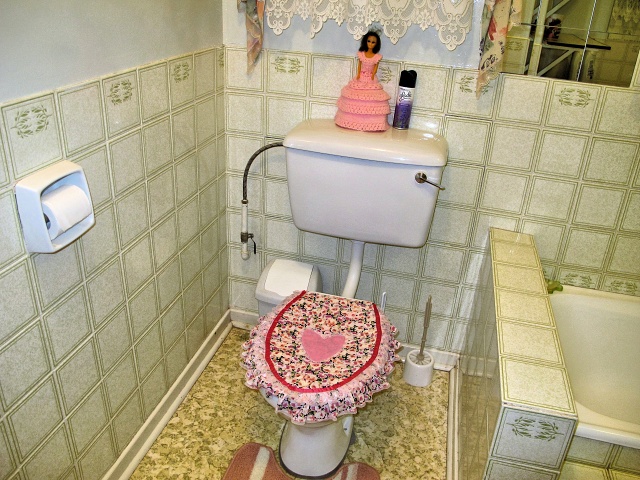
[Griquatown] Oude Windpomp Gastehuis – beautified toilet at the Old Windmill Guesthouse
The accommodation was great – clean, comfortable, cheap. I locked the bike with bags in the garage, and was given some welcome coffee. I arranged to have breakfast and paid a modest 250 Rands for all of this. I was as hungry as a wolf. My hostess (Bernita, as I later learned) would have cooked for me, but there was a restaurant in the village, and I did not want to bother her. I had a 300-g rump steak with boiled vegetables and immediately felt my body completely processing and immediately distributing all the nutrients obtained to the needy organs. And it worked really effectively. Nothing was wasted and I also did not need to go to the toilet for two days! There was no wastage from that meal!
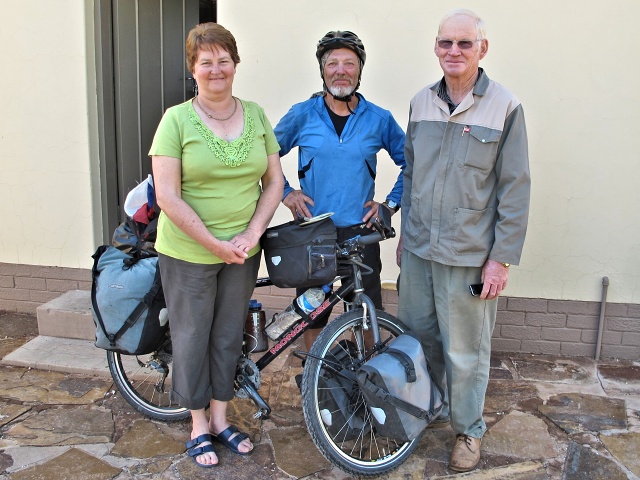
[Griquatown] Bernita Venter and her husband, owners of Oude Windpomp Gastehuis – especially great people
After returning from the pub, I had a discussion lasting almost two hours with the master of the house. He was very annoyed by the existing conditions in which people were given money for having children and not for working. He was a farmer, all his life he had worked hard with his hands, worked his way up from scratch and now owned hundreds of hectares, managed by his two sons. First of all, he bred sheep, but when wool stopped selling, he began to breed cattle for meat. He said he would have never thought of applying for State Aid in a bad year. In agriculture, one must count on this, and in a good year save money for the bad ones. And, of course, in the morning he was already in his overalls and allocating work to about six workers who started to amble about the garden. Bernita made me a fantastic breakfast: eggs, fried ham, sausages, muesli, yogurt, juice, coffee – I really ate my fill. Jokingly I told her that I would be able to cycle 100 km on this fuel. In fact, I did 170 km. And she gave me a box of freshly-made vetkoek (large fried donuts) for the journey. Aren’t those people amazing?
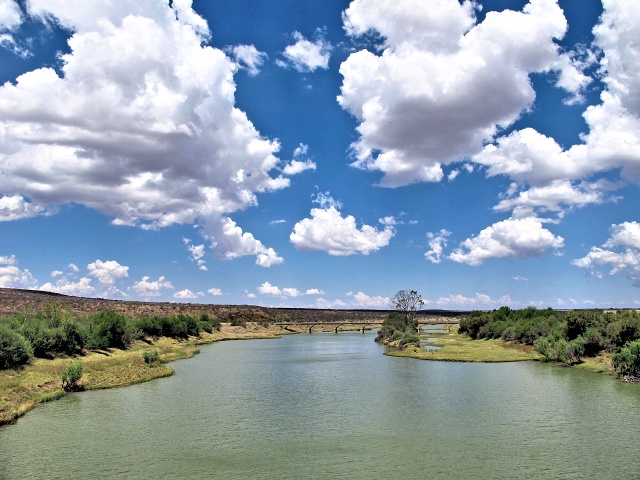
[East of Schmidtdrif] Crossing the Vaal River, the old bridge in the background
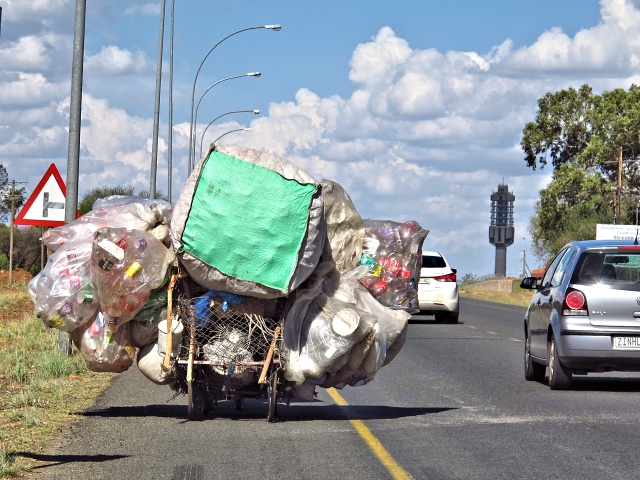
[Kimberley] Properly loaded, I still have much to learn
Kimberley
That fuel must have exploded within me, as I cycled 430 km in the next three days. 170 km on the last day, but this was the easiest – the first half was slightly downhill, the other slightly uphill, but with an especially strong wind behind me. Here the West wind dominates and so it was fine, the weather did not get any worse. I visited a tourist information center, got a map of the city and a ten-page list of accommodation options with prices. It was after 4 p.m. but I sat for half an hour and studied all the offers of accommodation. I ruled out those that were too expensive, and also those that were far from the center. Then I cycled to the selected ones, but had no luck, as all were full. And again the old problem, a closed guesthouse, no bell, only a phone number to call. I always mobilized someone to call for me, but I did not feel good about doing this.
I wondered whether I should buy a cellphone. I even went to a store and found that the cheapest new phone with a prepaid card cost 110 Rands (13 USD). The price included prepaid calls for the value of 10 Rands. A one-minute call cost 99 cents and was charged consecutively in seconds. In the end, I rejected buying a phone, I did not want to carry any more gadgets.
I had no luck anywhere. It was pretty late and so I was left with nothing but the Caravan Park. On the map, I had somehow overlooked the one that was near the Big Hole and, after some slight navigational problems, I arrived at the Kimberley Caravan Park. The problems were connected with the stupid local marking of the streets. The street names are written on the vertical edge of the curb, so they are often unclear or covered in dirt. The Caravan Park belonged among the ranks of worse to worst. Next to a poor black neighborhood. Most campers were workers living in trailers who were working there temporarily. I could not imagine leaving the bike locked to a tree next to the tent and finding it again in the evening. The owners of the camp argued with me that there was no theft problem. And they offered me an overnight stay in a caravan for a great 150 Rands. Yeah, that was different. The city center was 25 minutes away. Modest accommodation there was in the range of 350 Rands. The guesthouses did not have WiFi or any other Internet access, so I would have had to go to an Internet café anyway. I must say that Namibia was a lot better in this respect and WiFi was available at nearly every accommodation establishment.
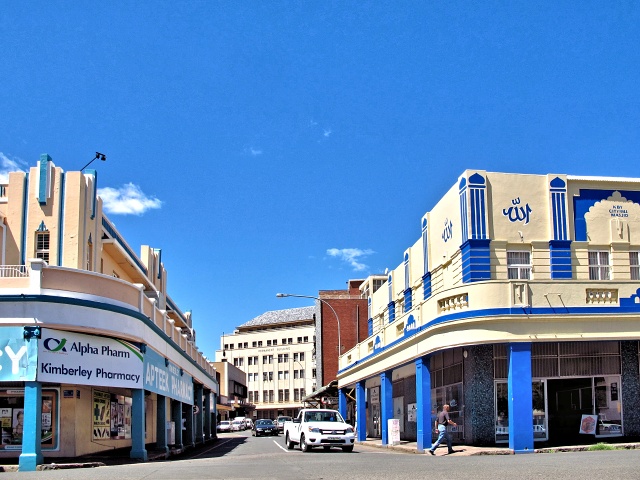
[Kimberley] Old city center of Kimberley
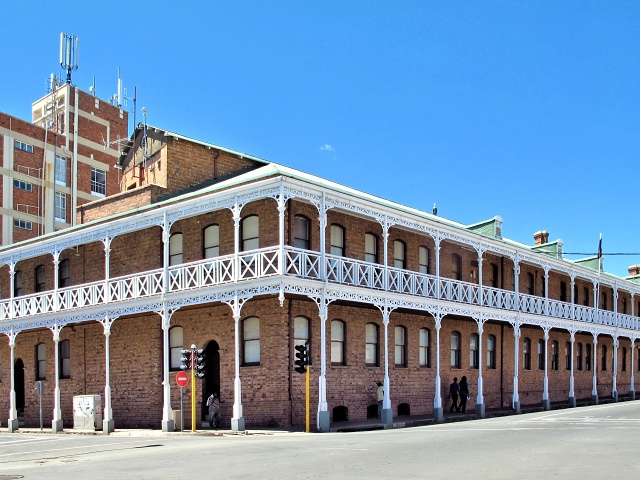
[Kimberley] The original De Beers headquarters
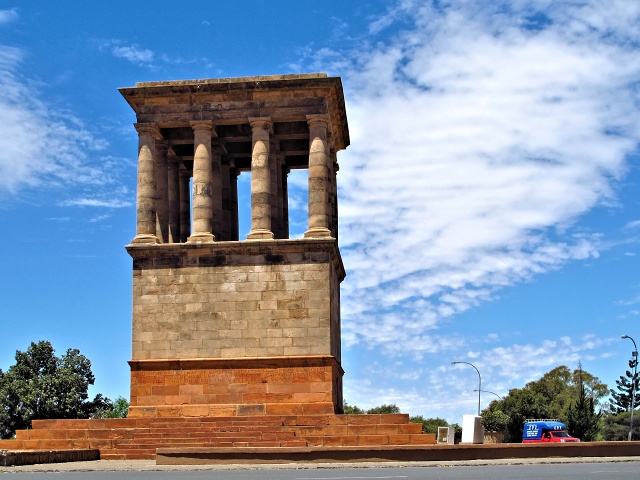
[Kimberley] The Honoured Dead Memorial – monument to the fallen during the siege of the city in the Anglo-Boer War – situated on the highest point of the city
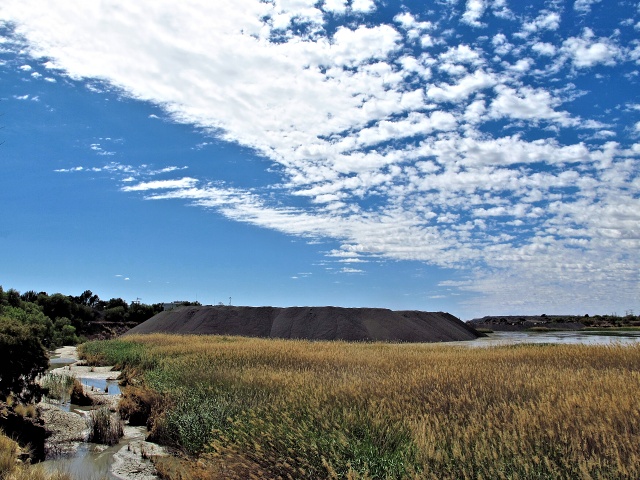
[Kimberley] This abandoned De Beers company mine, as well as four other mines, are located on the outskirts of the city
The Big Hole
The Big Hole is almost in the center of town. Originally, it was a flat mound, which, in the search for diamonds, was dug out and hollowed manually to a depth of 215 meters. Then underground mining continued down to 1,100 meters. In the early days of mining, the mound was divided into dozens of claims operated by private individuals. Most of the claims were then bought up by the diamond barons, Rhodes and Barnato. The history of local mining is interesting, but I do not feel entitled to describe it here. Personally, I was most fascinated by the fact that it was necessary to extract 22.5 million tons of soil to get only 2,722 kg of diamonds.
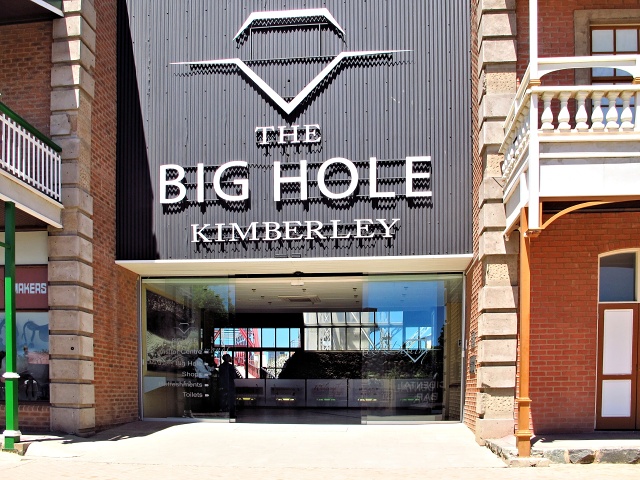
[Kimberley] Entrance to the complex

[Kimberley] A new viewing platform suspended above the excavation
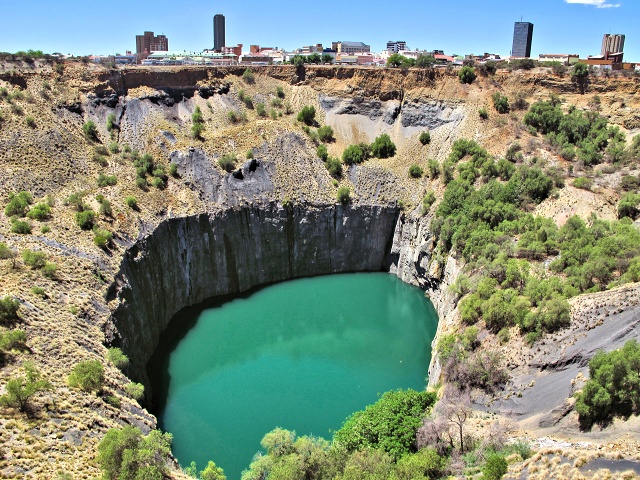
[Kimberley] The Big Hole – the largest hand-dug hole in the world

[Kimberley] Facts about the Big Hole - 2.7 tons of mined diamonds, 22.5 million tons of excavated soil, depth of hole: 215 m, depth from surface to water: 174 m
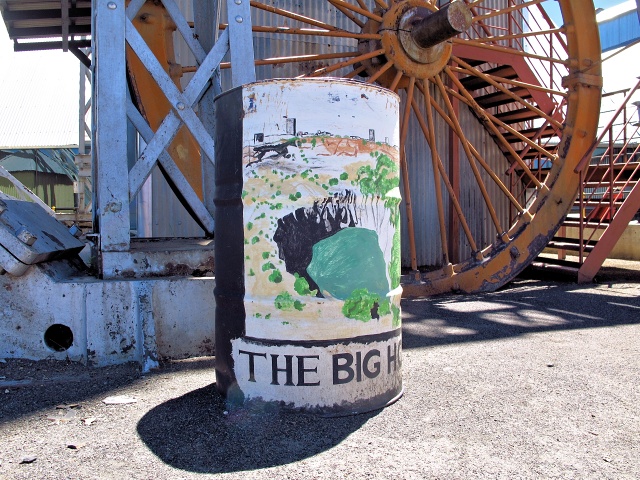
[Kimberley] Trash drum with a painting of the Big Hole
I got a Senior's discount on the admission. This was quite unique because, in most countries, these discounts apply only to local citizens. The tour was fascinating. Firstly, we were shown an interesting 20-minute film about the history of mining and the origin of diamonds, starring actors in the main roles. Then a view of the Big Hole in the ground from a new observation platform which enables one easily to see the excavated crater. Then an elevator down into the mine, which was really unique. The elevator was shaking, rattling and squeaking, giving the impression that we were descending several hundred meters underground. Eventually I found that it was actually only one floor. We stepped into the mine shaft, there again accompanied by various sound and light effects, dynamite explosions –very impressive. We left the mine and entered a heavily guarded room with samples of genuine diamonds, dominated by the biggest extracted raw diamond in the world. Many diamonds of various colors, sizes, raw as well as cut. Outside the guarded room were showcases with replicas of the world’s most famous diamonds.
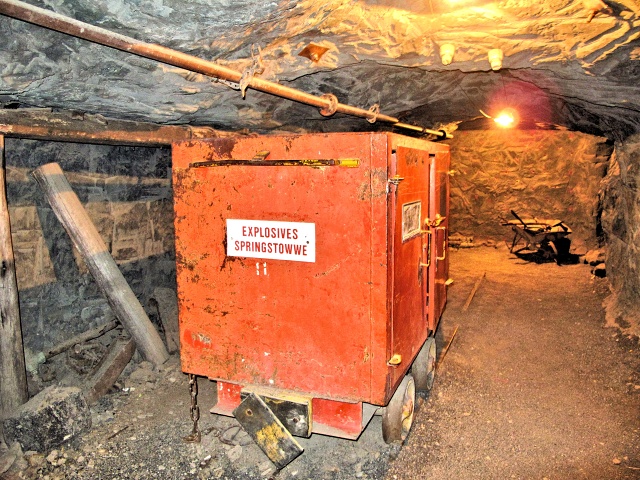
[Kimberley] Mine tunnel
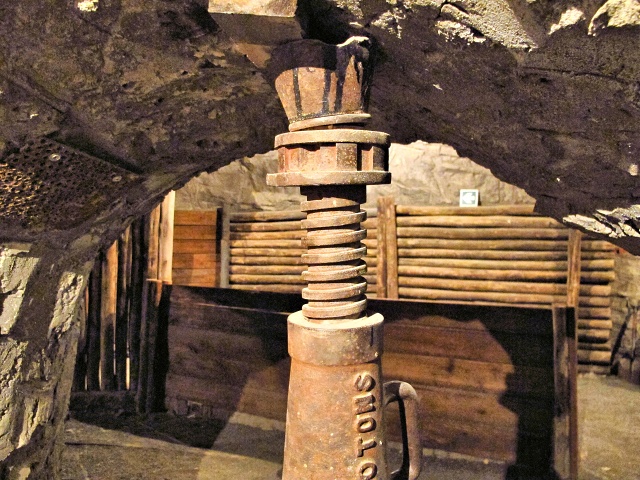
[Kimberley] Suspension props
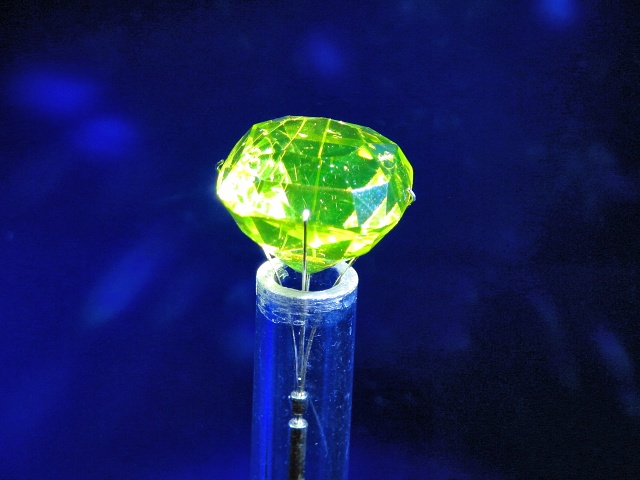
[Kimberley] Tiffany Diamond – replica
An open-air museum was constructed from the original buildings in the area. Of course, also several original pubs which numbered twice the number of churches at the time of Kimberley's greatest glory. I aptly concluded the tour with a mug of beer in one of those pubs.
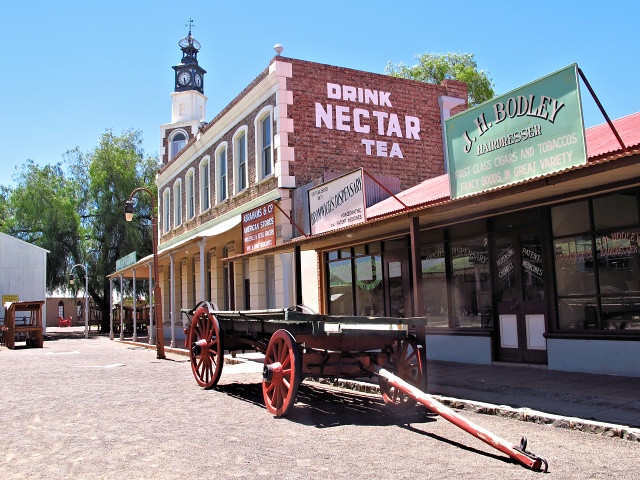
[Kimberley] The open-air museum – one of the buildings from the time of diamond fever

[Kimberley] Original bowling alley at the Big Hole open-air museum

[Kimberley] Bank building; at that time banks were not yet able to show off their wealth
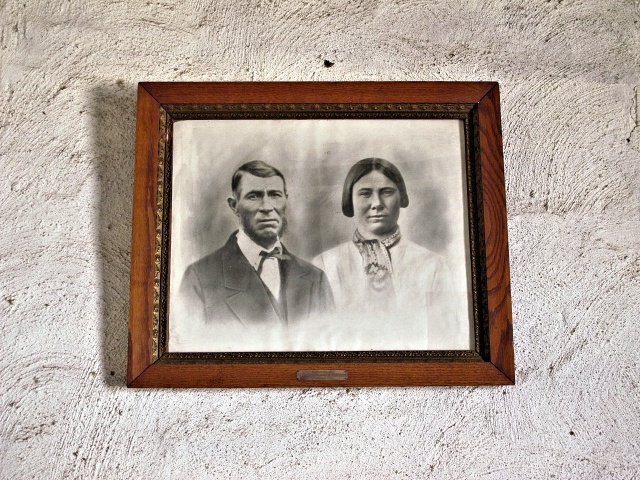
[Kimberley] Photographs of the house-owners on the wall of a home in the open-air museum
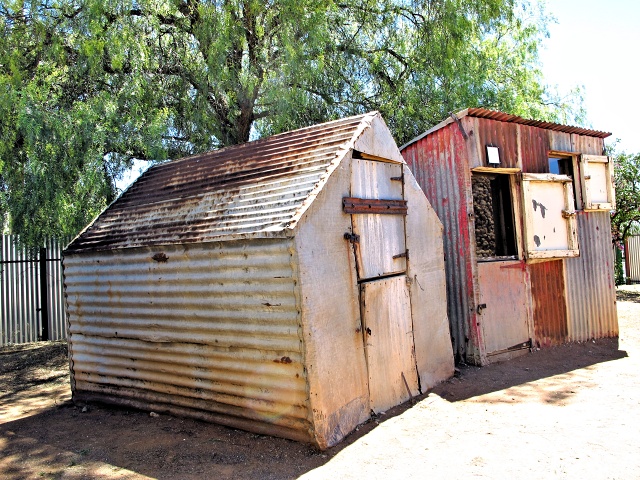
[Kimberley] Living conditions of local prospectors definitely did not reek of luxury; this could change by a single find
A Drunken Gallery
In the guidebook I read that the William Humphreys Art Gallery has the best collection of contemporary South African Art. I arrived at the Gallery, wanted to pay the entrance fee, but the man at the entrance, with slightly disturbed diction, told me that no fee was payable that day because, between the three people there, they had drunk three bottles of strong Cognac, and so entry was free. I could not concentrate much on the Art, as the gentlemen needed to talk. On that day, I was the second and probably the last visitor. On the other hand, they were nice, decently intoxicated people, which was also a good cultural experience for me!

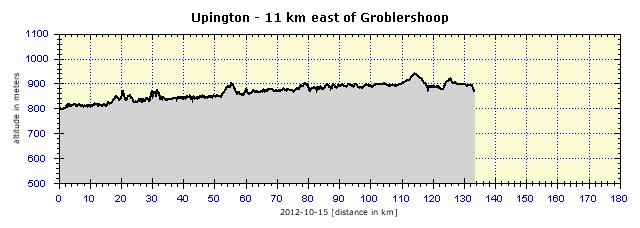


|

































